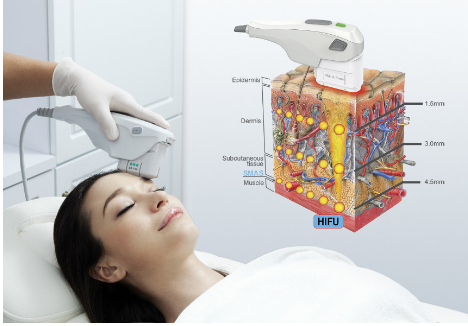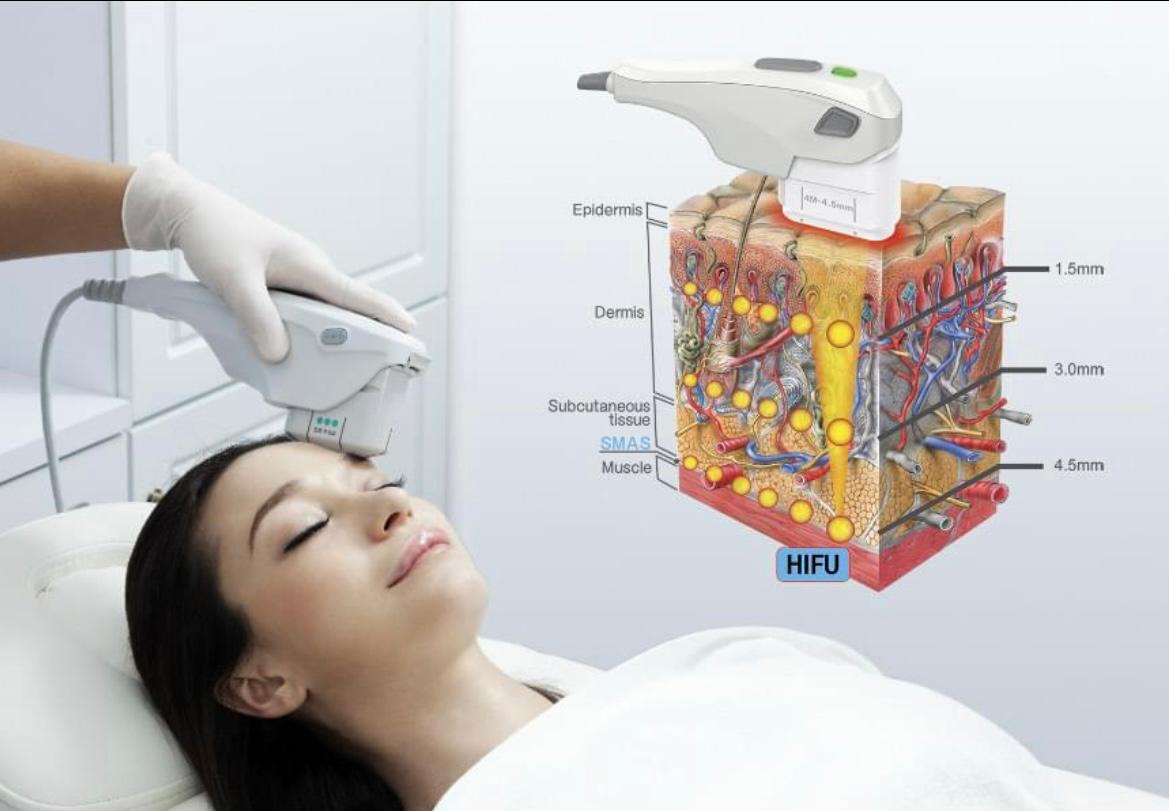High Intensity Focused Ultrasound (HIFU) has rapidly gained popularity in the field of aesthetics, providing a non-invasive, effective, and safe alternative to surgical procedures for facial lifting, wrinkle reduction, and body contouring. This advanced technology uses focused ultrasound waves to target specific layers of the skin, stimulating collagen production and tightening tissues, resulting in a more youthful and rejuvenated appearance. Here, we delve into the mechanisms, applications, benefits, and safety profile of HIFU in aesthetic treatments.
Mechanisms of HIFU
HIFU operates by emitting high-frequency ultrasound waves that are precisely focused on targeted areas beneath the skin’s surface. These waves converge at specific depths, generating intense heat that reaches temperatures between 60-70°C. This thermal effect causes controlled micro-damage to the underlying tissues, specifically targeting the Superficial Muscular Aponeurotic System (SMAS) layer, which plays a critical role in maintaining facial structure and skin elasticity.

The localized heat induces thermal coagulation points, which trigger the body’s natural healing response. This response involves the stimulation of fibroblasts to produce new collagen and elastin, essential proteins for maintaining skin firmness and elasticity. Over time, this process leads to the tightening and lifting of the treated area, improving skin texture and reducing the appearance of wrinkles and sagging.
Applications in Aesthetics
Facial Lifting and Tightening
HIFU is widely recognized for its efficacy in non-surgical facial lifting. It targets areas prone to sagging, such as the jowls, neck, and brow, providing a noticeable lift and improved skin elasticity. By focusing on the deeper layers of the skin, HIFU treatments can achieve results similar to those of a surgical facelift without the associated risks and recovery time.
Wrinkle Reduction
The stimulation of collagen production by HIFU effectively reduces the appearance of fine lines and wrinkles. It is particularly beneficial for smoothing out wrinkles on the forehead and the nasolabial folds. Patients often report smoother, firmer skin with a reduction in the depth and number of wrinkles after HIFU treatments.
Body Contouring
Beyond facial applications, HIFU is also used for body contouring and fat reduction. It can target stubborn fat deposits in areas such as the abdomen, thighs, and arms, promoting fat reduction and skin tightening simultaneously. The focused ultrasound waves penetrate the subcutaneous fat layer, causing fat cell destruction, which the body then naturally eliminates over time.
Improving Skin Texture and Tone
HIFU treatments enhance overall skin texture and tone. The increase in collagen and elastin leads to smoother, more even skin, reducing the appearance of pores and improving the skin’s overall quality. This results in a radiant, healthy-looking complexion that many patients desire.
Benefits of HIFU
Non-Invasive
One of the most significant advantages of HIFU is its non-invasive nature. Unlike surgical procedures, HIFU does not require incisions or anesthesia, significantly reducing the risks and complications associated with surgery. Patients can achieve noticeable aesthetic improvements without the need for invasive techniques.
No Downtime
HIFU treatments require little to no downtime. Patients can resume their daily activities immediately after the procedure, making it a convenient option for those with busy schedules. This minimal disruption to daily life is a significant benefit for many individuals seeking cosmetic enhancements.
Long-Lasting Results
The results of HIFU treatments develop gradually over several months as the body produces new collagen. These results can last up to a year or more, depending on the individual’s skin condition and aging process. The gradual improvement and long-lasting effects make HIFU a popular choice for those seeking sustained aesthetic benefits.
Minimal Discomfort
While some patients may experience mild discomfort during the procedure, it is generally well-tolerated. Any discomfort typically subsides shortly after the treatment, and side effects are minimal. This contrasts with the significant pain and recovery time often associated with surgical procedures.
Safety and Side Effects
HIFU is considered a safe procedure with a low risk of complications. Common side effects include mild redness, swelling, or tingling sensations in the treated area, which usually resolve within a few hours to a couple of days. Rarely, some patients may experience slight bruising or numbness, but these effects are temporary and typically resolve on their own.
To ensure safety and efficacy, it is crucial to have HIFU treatments performed by trained and certified professionals. Proper patient assessment and the use of appropriate ultrasound settings tailored to individual needs are essential for achieving optimal results.
Clinical Studies and Efficacy
Numerous clinical studies have demonstrated the efficacy and safety of HIFU in aesthetic treatments. Research has shown significant improvements in skin laxity, wrinkle reduction, and facial lifting, with minimal adverse effects. For example, a study published in the Journal of Cosmetic and Laser Therapy reported that HIFU treatment resulted in a significant increase in skin elasticity and reduction in wrinkle depth, with high patient satisfaction rates.
Another study in the Aesthetic Surgery Journal found that HIFU effectively reduced subcutaneous fat in treated areas, leading to noticeable body contouring results. These studies underscore the versatility and effectiveness of HIFU as a non-invasive cosmetic treatment.
Patient Selection and Treatment Protocol
Proper patient selection is crucial for achieving the best results with HIFU. Ideal candidates are those with mild to moderate skin laxity who seek non-invasive treatments for facial and body rejuvenation. Patients with severe skin laxity or extensive sun damage may require alternative or adjunctive treatments to achieve their desired outcomes.
The treatment protocol for HIFU varies depending on the area being treated and the specific needs of the patient. A typical facial treatment session lasts between 30 to 90 minutes, while body contouring sessions may take longer. Multiple sessions may be required to achieve optimal results, with follow-up treatments recommended every 12 to 18 months to maintain the effects.
Future Directions and Innovations
As HIFU technology continues to advance, new applications and innovations are emerging in the field of aesthetics. Researchers are exploring the use of HIFU for treating other cosmetic concerns, such as cellulite reduction and skin resurfacing. Additionally, combining HIFU with other non-invasive modalities, such as radiofrequency and microneedling, may enhance treatment outcomes and expand its therapeutic potential.
Innovations in HIFU device design are also improving treatment precision and patient comfort. Advances such as real-time imaging and adjustable treatment depths allow for more targeted and personalized treatments, ensuring optimal results for each patient.
Conclusion
High Intensity Focused Ultrasound has revolutionized the field of aesthetic medicine by offering a non-invasive, effective solution for skin tightening, wrinkle reduction, and facial rejuvenation. Its ability to stimulate collagen production and target deep layers of the skin without the need for surgery has made it a popular choice among patients seeking natural-looking, long-lasting results. With its safety profile and minimal downtime, HIFU continues to gain popularity as a reliable and innovative approach to aesthetic enhancement.
As technology advances and research continues, the applications and efficacy of HIFU in aesthetics are likely to expand, offering even more opportunities for non-invasive cosmetic improvements. For those seeking to enhance their appearance without the risks and recovery time of surgery, HIFU presents a promising option that delivers significant aesthetic benefits.

